Quick Fabrication VCSELs for Characterisation of Epitaxial Material
Abstract
1. Introduction
2. Materials and Methods
3. Results and Discussion
3.1. Threshold Current
3.2. Output Power
3.3. Emission Spectra
3.4. Wavelength Tuning
4. Conclusions
Author Contributions
Funding
Institutional Review Board Statement
Informed Consent Statement
Data Availability Statement
Acknowledgments
Conflicts of Interest
References
- Iga, K. Vertical-Cavity Surface-Emitting Laser: Its Conception and Evolution. Jpn. J. Appl. Phys. 2008, 47, 1–10. [Google Scholar] [CrossRef]
- Koyama, F. Recent Advances of VCSEL Photonics. J. Light. Technol. 2006, 24, 4502–4513. [Google Scholar] [CrossRef]
- Liu, A.; Wolf, P.; Lott, J.A.; Bimberg, D. Vertical-cavity surface-emitting lasers for data communication and sensing. Photonics Res. 2019, 7, 121–136. [Google Scholar] [CrossRef]
- Khan, Z.; Shih, J.-C.; Chao, R.-L.; Tsai, T.-L.; Wang, H.-C.; Fan, G.-W.; Lin, Y.-C.; Shi, J.-W. High-brightness and high-speed vertical-cavity surface-emitting laser arrays. Optica 2020, 7, 267. [Google Scholar] [CrossRef]
- Hayes, D.G.; Peach, T.; Baker, J.; Gillgrass, S.J.; Allford, C.P.; Sobiesierski, A.; Eng, C.; Shabbir, S.; Thomas, S.; Hentschel, C.; et al. 150 mm full wafer fabrication and characterization of 940nm emitting VCSELs for high-volume manufacture. In Vertical-Cavity Surface-Emitting Lasers XXV; Society of Photo-Optical Instrumentation Engineers (SPIE): San Francisco, CA, USA, 2021; Volume 11704, p. 1170406. [Google Scholar] [CrossRef]
- Johnson, A.; Joel, A.; Clark, A.; Pearce, D.; Geen, M.; Wang, W.; Pelzel, R.; Lim, S.W. High performance 940nm VCSELs on large area germanium substrates: The ideal substrate for volume manufacture. In Vertical-Cavity Surface-Emitting Lasers XXV; Society of Photo-Optical Instrumentation Engineers (SPIE): San Francisco, CA, USA, 2021; Volume 11704, p. 1. [Google Scholar] [CrossRef]
- Bowen, D.K.; Wormington, M.; Feichtinger, P.; Joyce, D.E. Full-Wafer Defect Identification using X-ray Topography. AIP Conf. Proc. 2003, 683, 284–288. [Google Scholar] [CrossRef]
- Hou, H.; Chui, H.; Choquette, K.; Hammons, B.; Breiland, W.; Geib, K. Highly uniform and reproducible vertical-cavity surface-emitting lasers grown by metalorganic vapor phase epitaxy with in situ reflectometry. IEEE Photonics Technol. Lett. 1996, 8, 1285–1287. [Google Scholar] [CrossRef]
- Lei, C.; Deng, H.; Dudley, J.; Lim, S.; Liang, B.; Tashima, M.; Herrick, R. Manufacturing of oxide VCSEL at Hewlett Packard. In 1999 Digest of the LEOS Summer Topical Meetings: Nanostructures and Quantum Dots/WDM Components/VCSELs and Microcavaties/RF Photonics for CATV and HFC Systems (Cat. No. 99TH8455); IEEE: San Diego, CA, USA, 1999; pp. 11–12. [Google Scholar] [CrossRef]
- Kim, Y.K.; Choquette, K.D.; Baker, J.E.; Allerman, A.A. Secondary ion mass spectrometry analysis of vertical cavity surface-emitting lasers. J. Vac. Sci. Technol. B Microelectron. Nanometer Struct. 2004, 22, 949. [Google Scholar] [CrossRef]
- Singh, J.; Bajaj, K.K.; Chaudhuri, S. Theory of photoluminescence line shape due to interfacial quality in quantum well structures. Appl. Phys. Lett. 1984, 44, 805–807. [Google Scholar] [CrossRef]
- Huffaker, D.L.; Deppe, D.G.; Kumar, K.; Rogers, T.J. Native-oxide defined ring contact for low threshold vertical-cavity lasers. Appl. Phys. Lett. 1994, 65, 97–99. [Google Scholar] [CrossRef]
- Lear, K.; Choquette, K.; Schneider, R.; Kilcoyne, S.; Geib, K. Selectively oxidised vertical cavity surface emitting lasers with 50% power conversion efficiency. Electron. Lett. 1995, 31, 208–209. [Google Scholar] [CrossRef]
- MacDougal, M.; Dapkus, P.; Pudikov, V.; Zhao, H.; Yang, G.M. Ultralow threshold current vertical-cavity surface-emitting lasers with AlAs oxide-GaAs distributed Bragg reflectors. IEEE Photonics Technol. Lett. 1995, 7, 229–231. [Google Scholar] [CrossRef]
- Geels, R.; Corzine, S.; Scott, J.; Young, D.; Coldren, L. Low threshold planarized vertical-cavity surface-emitting lasers. IEEE Photonics Technol. Lett. 1990, 2, 234–236. [Google Scholar] [CrossRef]
- Chua, C.; Thornton, R.; Treat, D. Planar laterally oxidized vertical-cavity lasers for low-threshold high-density top-surface-emitting arrays. IEEE Photon- Technol. Lett. 1997, 9, 1060–1062. [Google Scholar] [CrossRef]
- Coldren, L.A.; Corzine, S.W.; Mashanovitch, M. Diode Lasers and Photonic Integrated Circuits; Wiley: Hoboken, NJ, USA, 2012. [Google Scholar]
- Grabherr, M.; Jager, R.; Miller, M.; Thalmaier, C.; Herlein, J.; Michalzik, R.; Ebeling, K. Bottom-emitting VCSEL’s for high-CW optical output power. IEEE Photonics Technol. Lett. 1998, 10, 1061–1063. [Google Scholar] [CrossRef]
- Khan, Z.; Shih, J.-C.; Cheng, C.-L.; Shi, J.-W. High-Power and Highly Single-Mode Zn-Diffusion VCSELs at 940 nm Wavelength. In 2019 IEEE Photonics Conference (IPC); IEEE: San Antonio, CA, USA, 2019. [Google Scholar] [CrossRef]
- Khan, Z.; Ledentsov, N.; Chorchos, L.; Shih, J.-C.; Chang, Y.-H.; Shi, J.-W. Single-Mode 940 nm VCSELs With Narrow Divergence Angles and High-Power Performances for Fiber and Free-Space Optical Communications. IEEE Access 2020, 8, 72095–72101. [Google Scholar] [CrossRef]
- Chaqmaqchee, F.; Lott, J. Impact of oxide aperture diameter on optical output power, spectral emission, and bandwidth for 980 nm VCSELs. OSA Contin. 2020, 3, 2602–2613. [Google Scholar] [CrossRef]
- Das, N.C.; Chang, W. Mesa-size dependence characteristics of vertical surface-emitting lasers. J. Electron. Mater. 2004, 33, 972–976. [Google Scholar] [CrossRef]
- Wipiejewski, T.; Peters, M.; Thibeault, B.; Young, D.; Coldren, L. Size-dependent output power saturation of vertical-cavity surface-emitting laser diodes. IEEE Photonics Technol. Lett. 1996, 8, 10–12. [Google Scholar] [CrossRef]
- Baveja, P.P.; Kögel, B.; Westbergh, P.; Gustavsson, J.S.; Haglund, Å.; Maywar, D.; Agrawal, G.; Larsson, A. Assessment of VCSEL thermal rollover mechanisms from measurements and empirical modeling. Opt. Express 2011, 19, 15490–15505. [Google Scholar] [CrossRef]
- Sale, T.E. Vertical Cavity Surface Emitting Lasers. Ph.D. Thesis, University of Sheffield, Sheffield, UK, 1993. [Google Scholar]
- Michalzik, R. VCSELs: Fundamentals, Technology and Applications of Vertical-Cavity Surface Emitting Lasers; Springer: Berlin/Heidelberg, Germany, 2012. [Google Scholar]
- Koyama, F.; Kinoshita, S.; Iga, K. Room-temperature continuous wave lasing characteristics of a GaAs vertical cavity surface-emitting laser. Appl. Phys. Lett. 1989, 55, 221–222. [Google Scholar] [CrossRef]
- Tell, B.; Brown-Goebeler, K.F.; Leibenguth, R.E.; Baez, F.M.; Lee, Y.H. Temperature dependence of GaAs-AlGaAs vertical cavity surface emitting lasers. Appl. Phys. Lett. 1992, 60, 683–685. [Google Scholar] [CrossRef]
- Khan, N.I.; Choudhury, S.H.; Roni, A.A. A comparative study of the temperature dependence of lasing wavelength of conventional edge emitting stripe laser and vertical cavity surface emitting laser. In Proceedings of the International Conference on Optical Communication Systems, Seville, Spain, 18–21 July 2011. [Google Scholar]
- Jung, C.; Jäger, R.; Grabherr, M.; Schnitzer, P.; Michalzik, R.; Weigl, B.; Müller, S.; Ebeling, K. 4.8 mW singlemode oxide confined top-surface emitting vertical-cavity laser diodes. Electron. Lett. 1997, 33, 1790–1791. [Google Scholar] [CrossRef]
- Ashkenasy, N.; Leibovitch, M.; Rosenwaks, Y.; Shapira, Y. Characterization of quantum well structures using surface photovoltage spectroscopy. Mater. Sci. Eng. B 2000, 74, 125–132. [Google Scholar] [CrossRef][Green Version]
- Liang, J.S.; Huang, Y.S.; Tien, C.W.; Chang, Y.M.; Chen, C.W.; Li, N.Y.; Li, P.W.; Pollak, F.H. Surface photovoltage spectroscopy characterization of a GaAs/GaAlAs vertical-cavity-surface-emitting-laser structure: Angle dependence. Appl. Phys. Lett. 2001, 79, 3227–3229. [Google Scholar] [CrossRef][Green Version]
- Huang, Y.S.; Malikova, L.; Pollak, F.H.; Debray, J.-P.; Hoffman, R.; Amtout, A.; Stall, R.A. Surface photovoltage spectroscopy and normal-incidence reflectivity characterization of a 1.3 μm InGaAlAs/InP vertical-cavity surface-emitting laser structure. J. Appl. Phys. 2002, 91, 6203–6205. [Google Scholar] [CrossRef]
- Thibeault, B.J.; Strand, T.A.; Wipiejewski, T.; Peters, M.G.; Young, D.B.; Corzine, S.W.; Coldren, L.A.; Scott, J.W. Evaluating the effects of optical and carrier losses in etched-post vertical cavity lasers. J. Appl. Phys. 1995, 78, 5871–5875. [Google Scholar] [CrossRef]
- Choquette, K.D.; Chow, W.W.; Hadley, G.R.; Hou, H.Q.; Geib, K.M. Scalability of small-aperture selectively oxidized vertical cavity lasers. Appl. Phys. Lett. 1997, 70, 823–825. [Google Scholar] [CrossRef]
- Jungo, M.; Di Sopra, F.M.; Erni, D.; Baechtold, W. Scaling effects on vertical-cavity surface-emitting lasers static and dynamic behavior. J. Appl. Phys. 2002, 91, 5550–5557. [Google Scholar] [CrossRef]
- Young, D.; Scott, J.; Malhotra, V.; Coldren, L.; Kapila, A. Reduced threshold vertical-cavity surface-emitting lasers. Electron. Lett. 1994, 30, 233–235. [Google Scholar] [CrossRef]
- Naidu, D. Characterisation of Lateral Carrier Out-Diffusion and Surface Recombination in Ridge Waveguide Devices-ORCA. Ph.D. Thesis, Cardiff University, Cardiff, UK, 2009. [Google Scholar]
- Sale, T.E.; Roberts, J.S.; David, J.P.R.; Grey, R.; Woodhead, J.; Robson, P.N. Temperature effects in VCSELs. In Vertical-Cavity Surface-Emitting Lasers; Society of Photo-Optical Instrumentation Engineers (SPIE): San Jose, CA, USA, 1997; Volume 3003, pp. 100–110. [Google Scholar] [CrossRef]
- Chen, C.; Leisher, P.; Allerman, A.A.; Geib, K.; Choquette, K. Temperature Analysis of Threshold Current in Infrared Vertical-Cavity Surface-Emitting Lasers. IEEE J. Quantum Electron. 2006, 42, 1078–1083. [Google Scholar] [CrossRef]
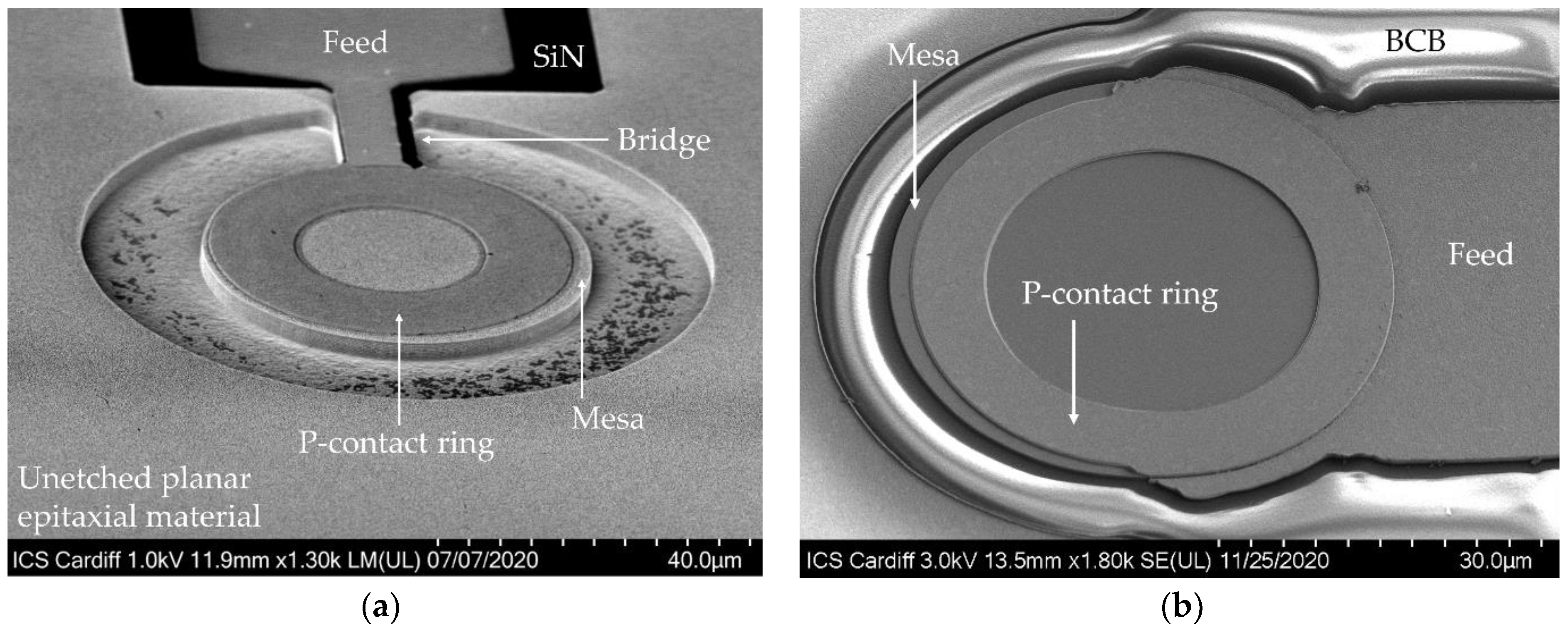
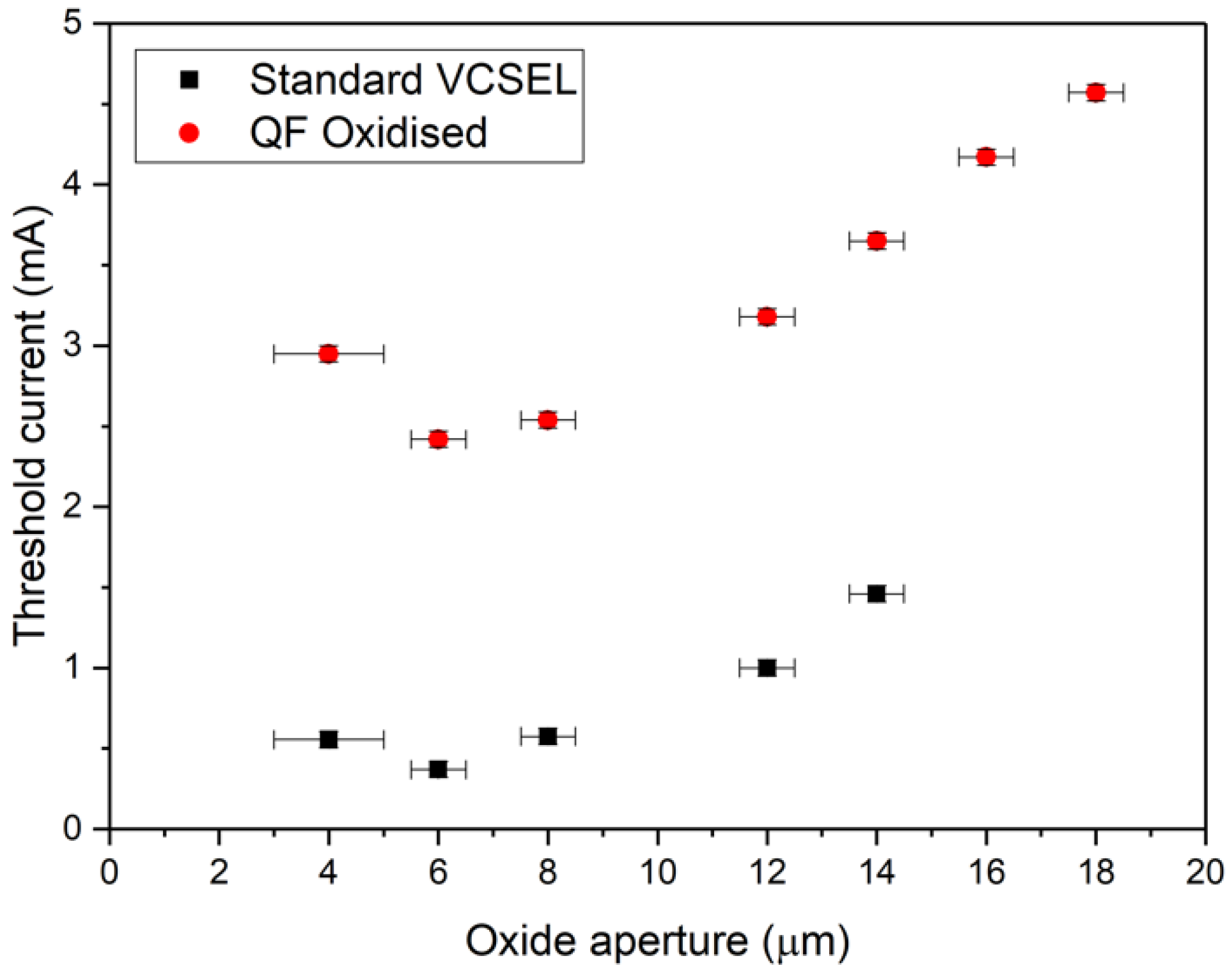
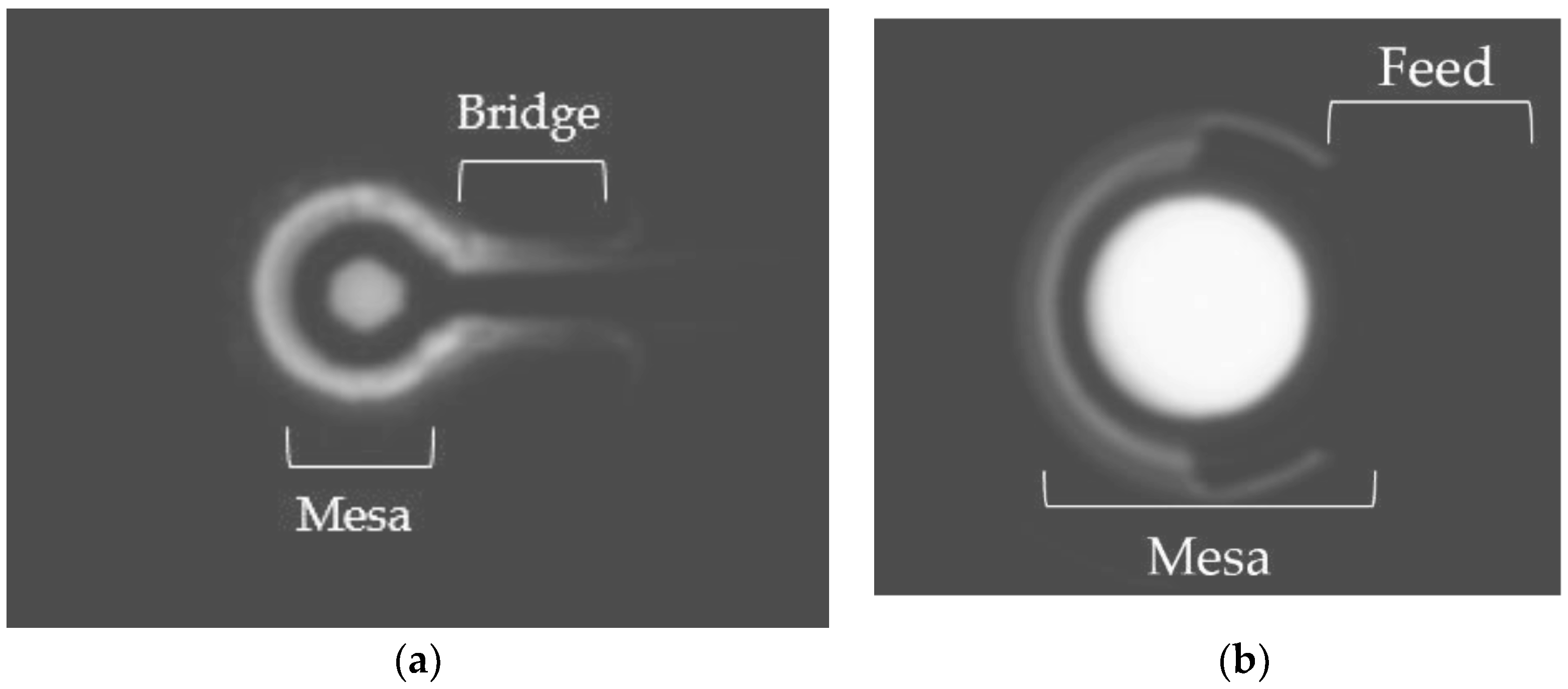
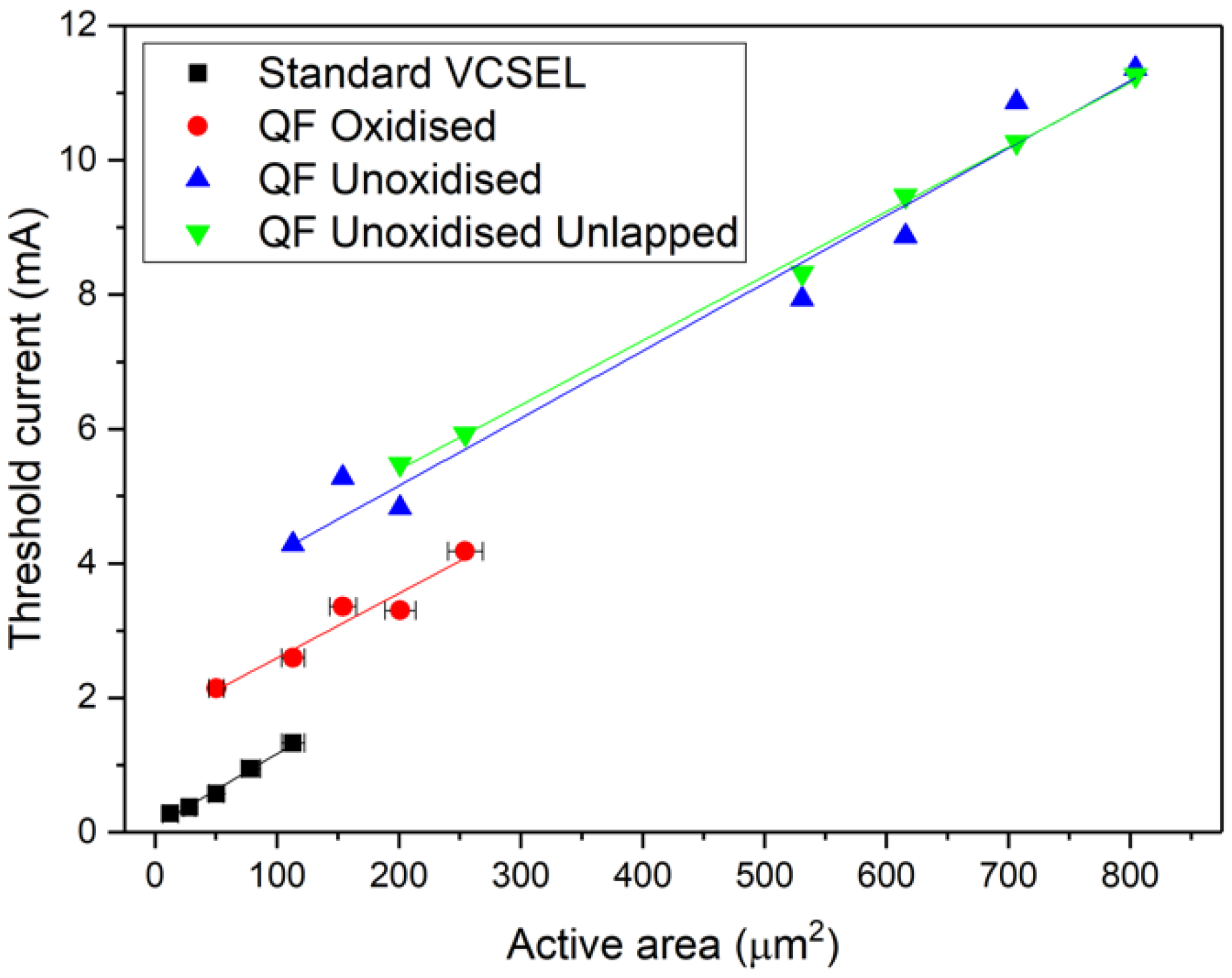
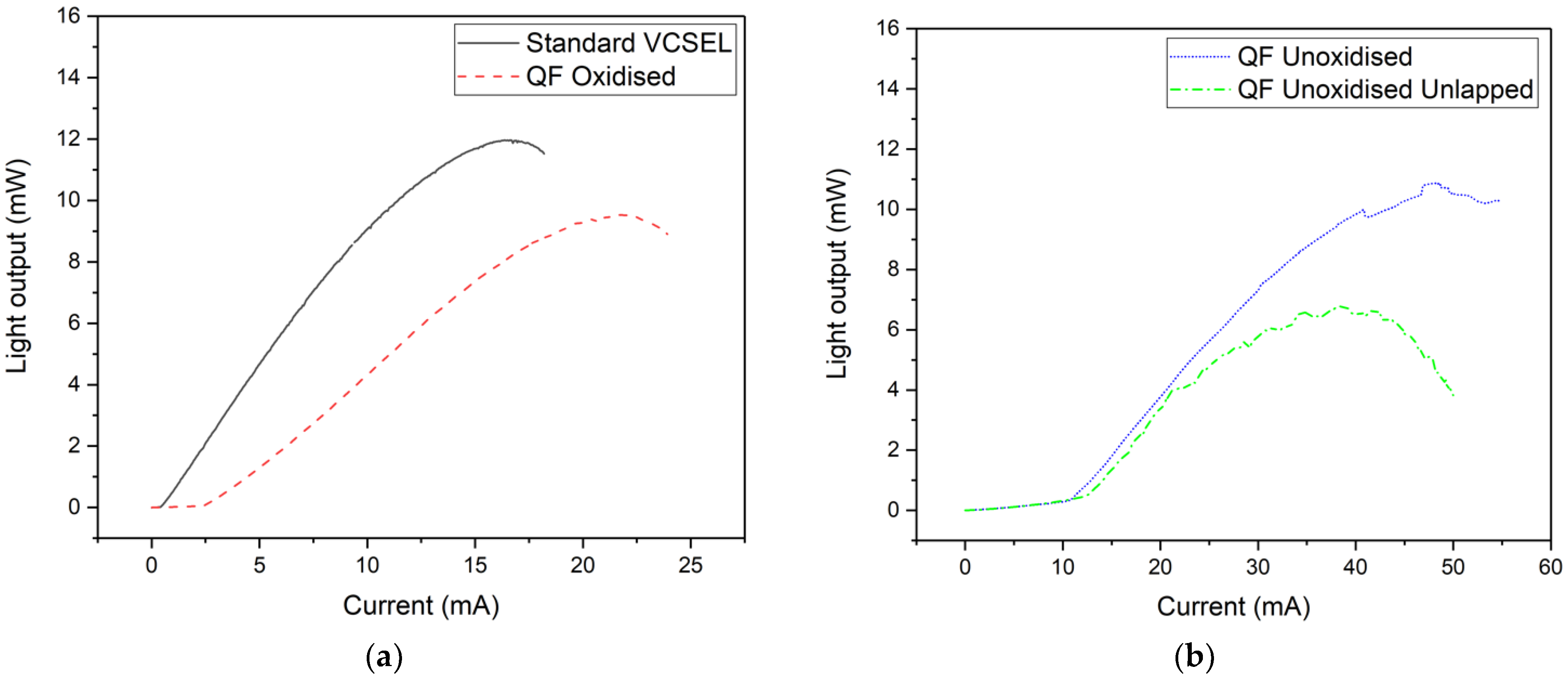
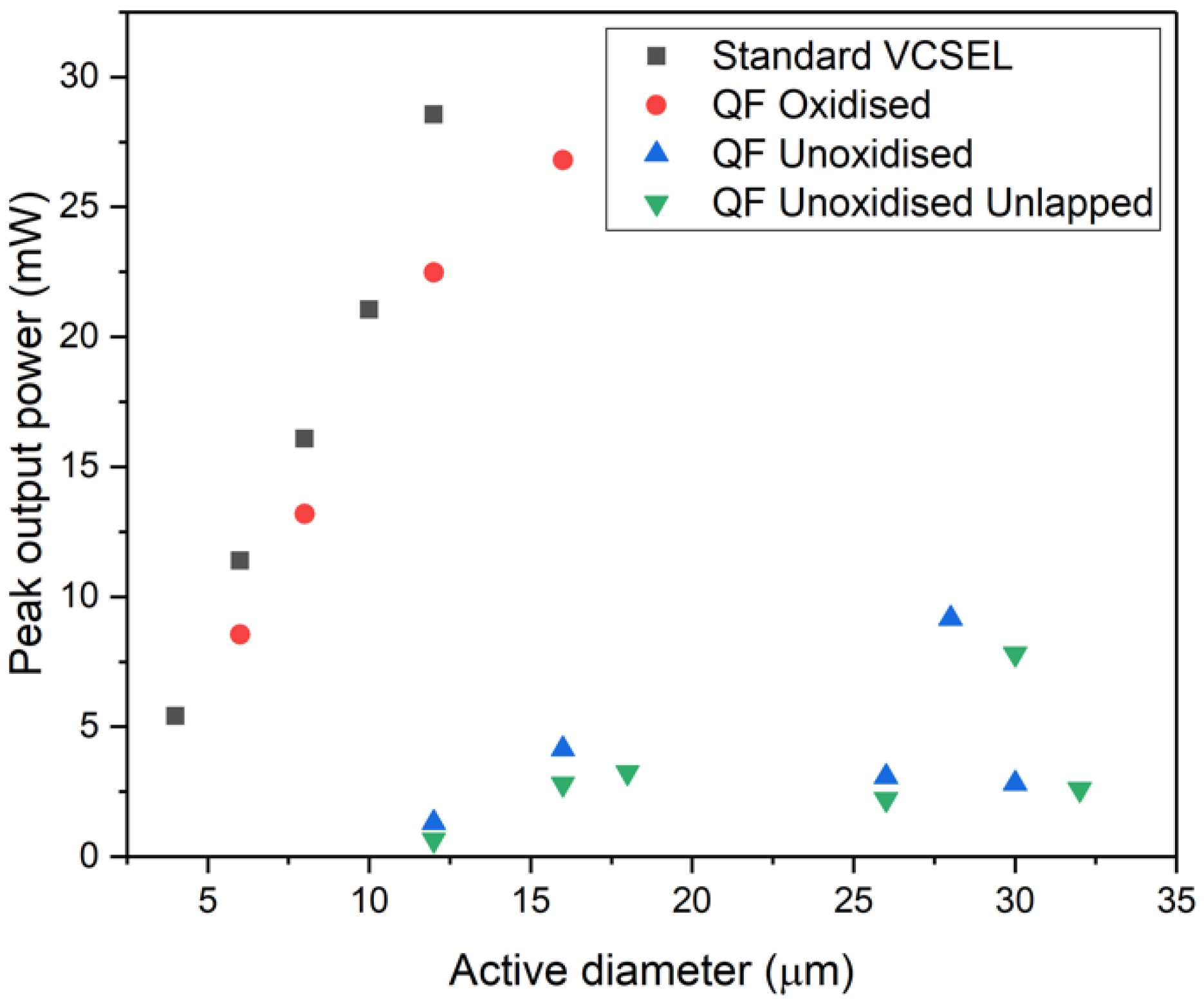

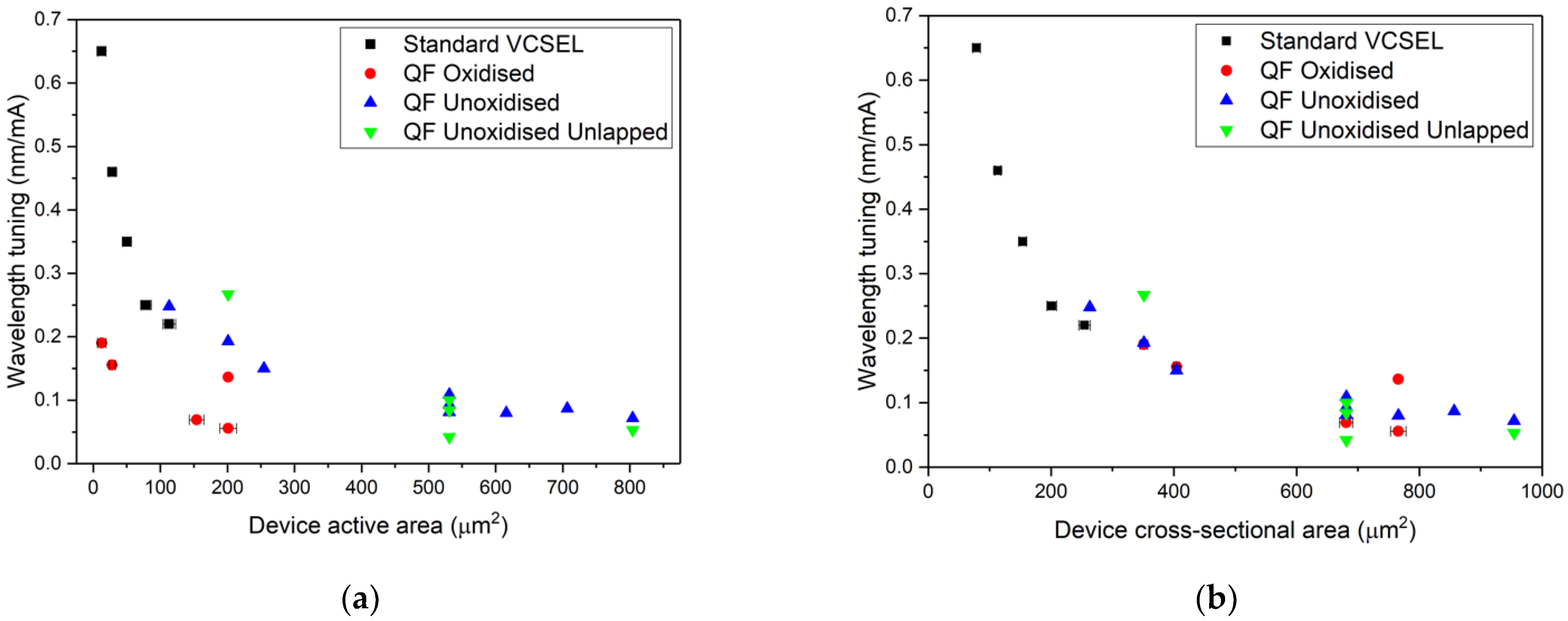
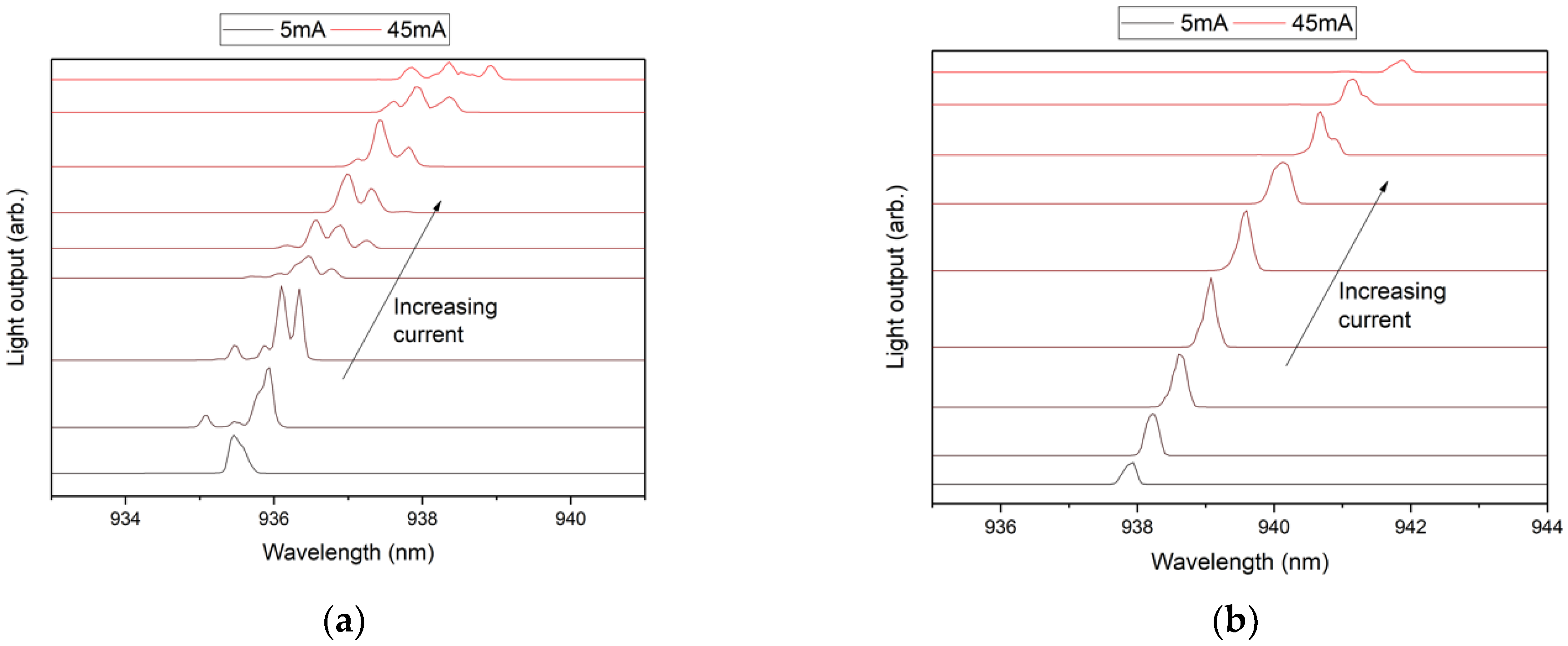
Publisher’s Note: MDPI stays neutral with regard to jurisdictional claims in published maps and institutional affiliations. |
© 2021 by the authors. Licensee MDPI, Basel, Switzerland. This article is an open access article distributed under the terms and conditions of the Creative Commons Attribution (CC BY) license (https://creativecommons.org/licenses/by/4.0/).
Share and Cite
Baker, J.; Allford, C.P.; Gillgrass, S.-J.; Forrest, R.; Hayes, D.G.; Nabialek, J.; Hentschel, C.; Davies, J.I.; Shutts, S.; Smowton, P.M. Quick Fabrication VCSELs for Characterisation of Epitaxial Material. Appl. Sci. 2021, 11, 9369. https://doi.org/10.3390/app11209369
Baker J, Allford CP, Gillgrass S-J, Forrest R, Hayes DG, Nabialek J, Hentschel C, Davies JI, Shutts S, Smowton PM. Quick Fabrication VCSELs for Characterisation of Epitaxial Material. Applied Sciences. 2021; 11(20):9369. https://doi.org/10.3390/app11209369
Chicago/Turabian StyleBaker, Jack, Craig P. Allford, Sara-Jayne Gillgrass, Richard Forrest, David G. Hayes, Josie Nabialek, Curtis Hentschel, J. Iwan Davies, Samuel Shutts, and Peter M. Smowton. 2021. "Quick Fabrication VCSELs for Characterisation of Epitaxial Material" Applied Sciences 11, no. 20: 9369. https://doi.org/10.3390/app11209369
APA StyleBaker, J., Allford, C. P., Gillgrass, S.-J., Forrest, R., Hayes, D. G., Nabialek, J., Hentschel, C., Davies, J. I., Shutts, S., & Smowton, P. M. (2021). Quick Fabrication VCSELs for Characterisation of Epitaxial Material. Applied Sciences, 11(20), 9369. https://doi.org/10.3390/app11209369





